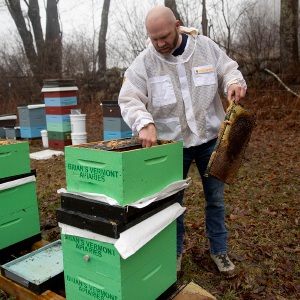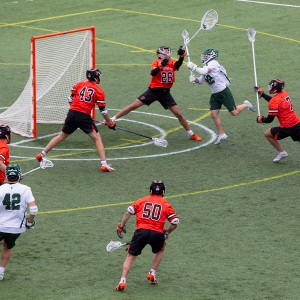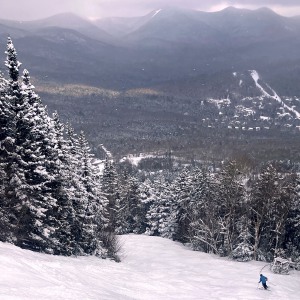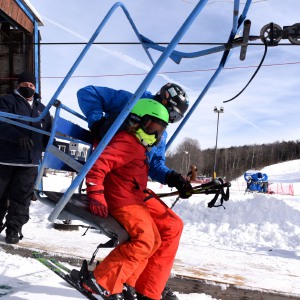Trail connecting Rivendell schools behind on maintenance
|
Published: 05-31-2024 7:01 PM
Modified: 06-01-2024 9:22 PM |
ORFORD — Maintenance challenges and issues with private landowners mean that about a quarter of the 36-mile Cross Rivendell Trail is closed and the people who care about it are pondering its future.
The trail was first founded about 25 years ago as a way of uniting the four towns which comprise the Rivendell Interstate School District, Orford, Fairlee, Vershire and West Fairlee. Over the years, students and community members worked to build and maintain what would become commonly referred to as the CRT. In 2003, a nonprofit organization, the Rivendell Trails Association, formed to oversee its maintenance, construction and fundraising.
For a time, the organization — with support from the school district — remained strong, but since the COVID-19 pandemic brought an exodus of board members, it has struggled to stay afloat. It also comes at a time when the Rivendell School District itself is in a period of turmoil, with changes in leadership and budget challenges. Earlier this year, residents defeated the proposed 2024-25 school budget and this Saturday will vote on a new budget proposal.
In late April, the four remaining board members sent out a newsletter stating their intentions to resign by the end of the year. Since the nonprofit organization also oversees maintenance of the CRT, if it dissolved the future of the trail could also be put in jeopardy.
“We are all busy, with full time jobs and families, and simply cannot commit to keeping this going anymore, especially with so few of us to spread the work between,” they wrote in the newsletter, noting that there are spots
This Sunday at 4 p.m. at Lake Morey Resort, the trails association will host a meeting to discuss its future, as well as that of the trail.
“I’m hopeful that it’s not the end, it’s more just a transition. It may be that the trail organization looks a little different going forward, depending on what people can bring to the table,” Maggie Stoudnour, who has served on the board for around a decade, said in a phone interview. “Hopefully we can keep the trail open and keep it going.”
More than 25 years ago, a group of community members and educators attended a conference to discuss ways to unite the four towns, who had been discussing establishing a single school district.
Article continues after...
Yesterday's Most Read Articles
 Hartford Selectboard mulls closing road off Sykes Mountain Ave
Hartford Selectboard mulls closing road off Sykes Mountain Ave
 After a year of looking, White River Junction couple finds new home
After a year of looking, White River Junction couple finds new home
 Upper Valley beekeepers assess winter losses
Upper Valley beekeepers assess winter losses
It was the summer of 1998 and plans were in the works to form the Rivendell Interstate School District; voters would later approve the proposal in October. That summer, community members began discussing ideas to bring residents of the four towns together. During a brainstorming session at a conference Kathy Hooke attended, group members were examining a map of the four towns when inspiration struck.
“We said ‘what if there’s a trail that connected the two high points of the district?’ ” Hooke, now a member of the Rivendell School Board, said in a phone interview.
The trail would start on Mount Cube in Orford and end on Flag Pole Hill in Vershire, with stops at the new district’s three schools — Samuel Morey Elementary School, Westshire Elementary School and Rivendell Academy. “It was an ah-ha moment.”
The Rivendell Interstate School District started operations in fall 2000 and the following summer a Rivendell student summer trail crew led by David Hooke — Kathy’s husband — and Sally Tomlinson built the first section of the CRT, which was funded by a grant through the New Hampshire Recreational Trails program. They started with a 2-mile section to the summit of Mount Cube in Orford, then got to work plotting the rest of the trail’s path through Vermont. Part of that work included getting permission from about 60 private landowners to put a public trail through their land.
“People were incredibly generous,” said David Hooke, who currently serves as the school district’s moderator. “Once some parts of it started coming together, other parts fell in place.”
Over the next five or so summers, Rivendell students continued to work to build out the trail and by the end of 2005 it was mostly complete. District educators served on the Rivendell Trails Association’s board and teachers regularly incorporated the CRT in lesson plans. The Hookes recall school-wide hikes that involved students and their families.
“It has served, historically, as a real strengthener in school/community relations and provided a core focus for outdoor education for the three schools,” Kathy Hooke said.
The Rivendell Trails Association and Rivendell School District jointly funded the salary of a part-time trails coordinator, a position that Stoudnour held from 2015 to 2020.
In 2020, the memorandum of understanding that the district had with the nonprofit expired and was not renewed, Rivendell’s business manager Nancy Murphy wrote in an email.
After 2020, the responsibilities of the trails coordinator — which involved writing grants, planning events and fundraisers, working with private landowners and keeping track of maintenance needs — fell to the trails association’s board members, who were dwindling in number.
“The trails coordinator was really pulling everyone together and keeping the ship afloat,” Stoudnour said. A couple years ago, a board member who had taken the lead on overseeing trail maintenance moved out of the area. “We were kind of left without anyone on the board who could actually make some of that trail work happen.”
Remaining board members tried to replace each departing member, but have not had success.
“We have had a few new recruits join, and shortly resign, citing lack of time and energy,” the board wrote in its April newsletter. “We have approached many about joining the Board, and been told the same by all: ‘I want to support you, and I am happy to pitch in on specific projects, but I don’t have time to commit to being on the Board.’ ”
Russell Hirschler, executive director of the Upper Valley Trails Alliance, a Norwich-based nonprofit organization that works with trails organizations on maintenance projects, said that plans are in the works for members of its summer trail corps to do work on parts of the CRT this summer. But even with that assistance, it won’t be enough. Worst-case scenario, sections of the trail would fall into disuse.
“It would be like an old footpath that goes through the woods,” Hirschler said. “It wouldn’t be a viable trail over time.”
Towns, individual landowners and other organizations would be left to figure out which parts they want to preserve on their own.
“I would hate to see for the trail system to die out but I don’t know that there’s an easy way for it to go forward unless we find that whole new board of people is ready to step in and do some major revitalization,” said Paige Radney, who used to teach at Rivendell Academy and has served on trails association’s board since 2016.
Individual landowners have continued to maintain certain sections. Around a mile of the trail goes through property Jack Kruse owns in Vershire.
His daughter, Ida Kruse, served on a trail crew that built that section of trail.
“I keep the trail open, mostly with loppers and a scythe. Sometimes I need a chainsaw,” Kruse wrote in an email. “And sometimes, I go to clear it, and someone has already done so. I love that. I also like seeing the tracks of skiers, hunters, and hikers, over the course of the year.”
Vershire resident Eleanor Zue helps maintain a roughly mile-long stretch of the CRT on Chamberlain Hill through the trails association’s Trail Adopter Program.
She likes being out on the trail, where she can’t hear sounds from roadways; during her hours on the CRT, she instead heard hermit thrushes.
“It’s a stunning accomplishment that they got it to happen in the beginning,” Zue said about the trail. She hopes that if the Rivendell Trail Association disbands, towns will step up to keep it going. “I would like to certainly be involved in the Vershire sections of it, in my small way.”
At the time the CRT was built, David Hooke and others asked landowners for “permission” for the trail to cross their land. That permission was typically attached to the person, not the land itself. The trail was primarily funded by grants and back then funders were content with landowners granting permissions versus easements, which are more permanent, David Hooke recalled.
Over time, as land has changed hands some of those permissions have been revoked and the trail is no longer continuous.
“At this moment I cannot imagine that we could have built this trail in Vermont at least with the rules that are currently in effect,” David Hooke said, adding that grant funders now require a stronger agreement with private landowners. “There are some significant sections that are permanently protected but … it would be the best if you could figure out how to get landowners to give permanent easements.”
There’s a lot of work that goes into managing trail networks, Hirschler said, especially those that involve so many private landowners.
“There’s two components really to managing the CRT: One is the trail itself and making sure it’s actually passable,” he said during an interview.
That includes repairing bridges, clearing brush and making sure the trail is passable.
“The other is the stewardship of the relationships between the trail and the landowners and often that takes more time than the trail maintenance itself,” he said.
Stoudnour and Hirschler agreed that it is easier to find people to volunteer for trail work days and harder to find people to do the necessary work behind the scenes.
“We really need that ongoing volunteer who’s kind of planning events, finding the grants that we can get help writing, planning the trail work days that we would have people come to,” Stoudnour said.
At Sunday’s meeting, Stoudnour and Radney hope that community members will step up to keep the organization going, or come up with new ideas to maintain the CRT.
The Hookes, too, are hopeful that the support they witnessed when the trail first started will reemerge.
“Sometimes it just takes being honest about where things are at for people to really come forward,” Stoudnour said.
Liz Sauchelli can be reached at esauchelli@vnews.com or 603-727-3221.








 Men’s lacrosse: Big Green finally holding serve in Ivy League
Men’s lacrosse: Big Green finally holding serve in Ivy League New Hampshire lawmakers target another source of PFAS: waxes used by skiers and snowboarders
New Hampshire lawmakers target another source of PFAS: waxes used by skiers and snowboarders Whaleback seeks support to repair and replace ski lift
Whaleback seeks support to repair and replace ski lift Girls hockey: Hanover dominates Oyster River-Portsmouth, repeats at state champ
Girls hockey: Hanover dominates Oyster River-Portsmouth, repeats at state champ
